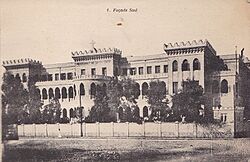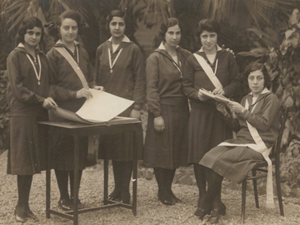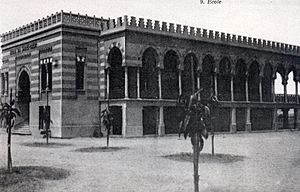Collège du Sacré-Cœur (Egypt) facts for kids
Quick facts for kids Collège du Sacré-Cœur |
|
|---|---|

South façade of College du Sacre Coeur Heliopolis in 1929
|
|
| Location | |
|
Cairo, Heliopolis
|
|
| Coordinates | 30°04′12″N 31°16′03″E / 30.0699°N 31.2676°E |
| Information | |
| Religious affiliation(s) | Catholic church |
| Established | 1 March 1904 |
| Founder | 7 Sisters (1904) Ismail Sidky (1911) |
| Years offered | 14 years |
| Affiliation | School of the Sacred Heart |
Collège du Sacré-Cœur is a French-language school in Cairo, Egypt. It's a Roman Catholic school. The school has two main locations. The first campus opened in Ghamra in 1904. A second campus started in 1911 in Heliopolis. Even though it's called a "collège" (which usually means a middle school), it teaches students from nursery all the way through high school. It is also part of The Network of Sacred Heart Schools.
Contents
History of Collège du Sacré-Cœur
Early Beginnings and New Campuses
The Collège du Sacré-Cœur began in 1904. It was first known as Pensionnat du Sacré-Cœur. This means "Sacred Heart boarding school". In 1911, a second school was added. This happened because Ismail Sidky wanted to offer French classes. He wanted them for the new city of Heliopolis.
The building for the Heliopolis school was built in the 1900s. It had a special Heliopolis style. This style was inspired by Eastern designs. These designs were created by Édouard Empain. At first, only a few girls attended the school. Most of them were from Europe. Over time, the school grew quickly. Most students became Egyptian citizens.
School's Role During World Wars
During the First World War, the school helped people. It became a safe place for those escaping from the Ottoman and German empires. The school also served as a chapel and camp for Australians. Students at the school helped people who were hurt. They aided them at a hospital set up at the Heliopolis Palace Hotel.
Similarly, during the Second World War, the school welcomed many people. These were refugees escaping from France. France was occupied by Nazi forces at that time.
Changes After the Egyptian Revolution
After the Egyptian revolution of 1952, the school changed a lot. It stopped being a Catholic boarding school. Instead, it focused on day classes. It also opened its doors to students who were not Christian.
At the same time, the school changed its teaching style. It moved from a purely French system. It started using a new "franco-egyptian" curriculum. This curriculum focused on the French language.
Modern Certifications
In 2005, the school received a special certification. The Institut Français gave them this approval. This meant the school could offer courses. These courses help students get ready for the French Baccalauréat exam. However, the school does not offer the exam itself.
Architecture and Design
Unique Heliopolis Style
The school's campus in Heliopolis is known for its special architecture. It has a unique neo-Mamluk style. This style was partly designed by Édouard Empain. It was part of his plan for the city he built.
The school became an important symbol of the neighborhood in Cairo. It was even shown in a graphic novel and an art display in Dubai.



